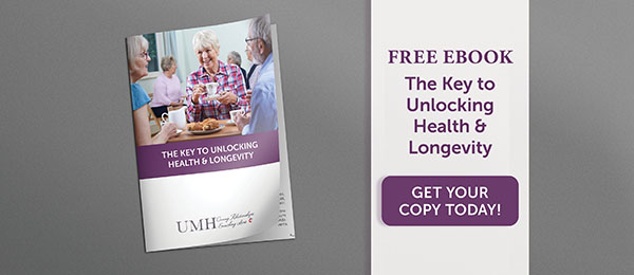How a Sense of Community Enables Seniors to Thrive
senior health | Independent Senior Living | the journey of aging
There’s no shortage of challenges seniors face when it comes to staying connected to the larger community. From diminished mobility and lack of transportation options to the inevitable loss of family and friends in their social circle, it can be difficult to maintain a strong base of human relationships and a wide sense of community. But these aspects of a senior’s life are critical to healthy aging and the capacity to thrive.
Consider for a moment that social contact is an even more powerful predictor of health and longevity than physical exercise or even whether or not a person smokes, according to studies in social neuroscience. In fact, people with active, in-person social lives have a 2- to 15-year lifespan advantage. That human connection piece is also a powerful biological indicator of how well people can think, remember facts and mitigate brain ailments such as dementia.
So when we talk about the role community plays in the life of a senior, it’s clear that the impacts are undeniably profound. And one of the most obvious and effective ways to foster and sustain a strong sense of community is through the choice of residence. If you or the senior in your life could benefit from a more supportive “village,” it may be time to consider the advantages of a senior living community. Here are some fundamental ways this option provides the crucial sense of community that enables seniors to truly thrive.
Built-In Network of Neighbors & Friends
In so many respects, this type of living creates the ultimate sense of community because it’s based on the very concept of living in close proximity to others. From neighbors and friends to staff and volunteers, there’s immense opportunity for human contact on a range of levels. It’s the place where seniors can garner a feeling of belonging and comfort simply by living among other residents and interacting with the people around them.
This is a stark contrast to seniors who live at home, feeling lonely and waiting around for busy family members to call or visit. If you or your aging loved one is limited in mobility or otherwise unable to get out and meet new people, there’s a serious risk of mental and physical decline. It’s just not as easy to nurture friendships, make connections and connect to the community, which can create a perfect storm for isolation, depression, and a severely diminished quality of life.
Independent But Not Alone
Community living and personal independence actually go hand-in-hand, however counterintuitive that might seem. It works something like this: The ongoing availability of community and social interaction cultivates mental and physical health, which in turn enables seniors to live more independently (as opposed to requiring increased assistance with daily routines and activities). Essentially, it’s about living life more independently as a result of living among a community that helps you thrive.
And for those willing to embrace the kind of assistance and support that comes with living in a senior living community, they find that opening themselves up to outside help gives them greater energy and enthusiasm for living an enriched and purposeful life—the very essence of independence. With a customized care plan that’s uniquely designed to promote independence, seniors not only maintain dignity and usefulness but also thrive in ways they might never have imagined.
To be clear, senior living doesn’t mean you have to be around people all the time. When you require time and space to yourself, it’s there for the taking. But the larger community still exists, and it’s available for social interaction, human connection, and a sense of purpose when those needs must be met.
Calendar of Connection
With a large resident group coming together to share common interests, you can’t help but feel a sense of family, friendship, and overall togetherness. The planned activities and opportunities for socialization help to relieve boredom and loneliness, and each interactive event builds on relationships and deepens friendships. It’s no surprise that close relationships are formed in such a communal setting with ongoing reasons to gather and enjoy people’s company.
Many senior living communities publish a monthly or weekly activities calendar that lists the different programs and events that are being offered on particular days. This might include anything from a daily exercise class and discussion groups to weekly shopping trips, movies, volunteer opportunities, and more.
Plus, they usually make transportation more accessible for older adults—a particular asset when driving becomes a safety or financial issue, and being transported by a caregiver is not always practical. Shuttling seniors anywhere from shopping centers and attractions to local fairs and cultural events makes socialization and connection to the community that much more attainable.
Access to Indispensable Support
The thing about community is that it encompasses so much more than simply being around other people; it also connects you with a vital system of support. And while support can mean lots of different things to different people, it often manifests for seniors in the form of emotional support from other community members as well as physical support via critical services.
The emotional side goes back to the availability of friendships and connections with neighbors. As you develop these relationships, you find there are people looking out for you, who care about you, and whom you can lean on in times of difficulty. There’s no substitute for having this kind of deep, human connection to rely on.
The physical side is what many senior living communities strive to accommodate through care and support services that maximize residents’ quality of life. These services are wide-ranging and could include offerings like on-site physical, occupational, or speech therapy, medication support, assistance in short or long-term rehab care, transportation for medical appointments, an emergency response system, security services, food and laundry services, and even household and yard maintenance.
All of this adds up to the kind of indispensable community support that seniors who seek to truly thrive can rely on. And it’s all within reach at the right senior living community for you or the senior in your life.
To find out how United Methodist Homes provides a wealth of offerings and opportunities to support the health and wellbeing of our residents, contact us today or schedule a complimentary visit now. For additional tips on senior health and lifestyle issues, check out our blog.
About Elizabeth Bemis
In 1998, I drove past an assisted living community construction site, learned that it was part of United Methodist Homes and realized the next stop on my professional journey was to work for a mission driven organization. Soon after, I joined the team as Executive Director of our Middlewoods of Farmington community and later served as Regional Manager for the Middlewoods properties before accepting my current role as Vice President of Marketing, Promotions, and Assisted Living Operations. I enjoy spending time with my family, cooking, reading, walking, and love working alongside our staff, residents, and families to build strong communities that reflect the mission, vision, and values of United Methodist Homes.

Our Blog is a 2016 Platinum Generations Award Winner! The Generations Award is an annual international competition for excellence in senior marketing recognizing professionals who have communicated to the 50+ Mature Markets.





